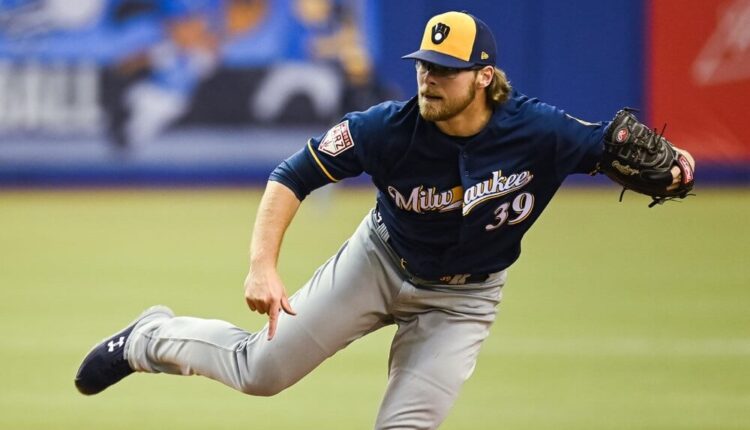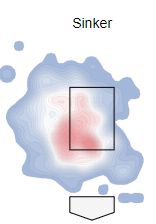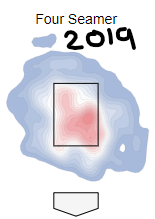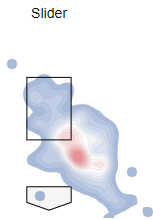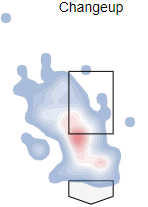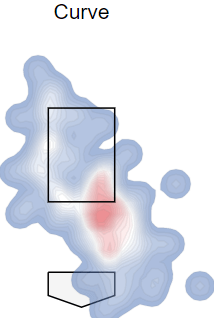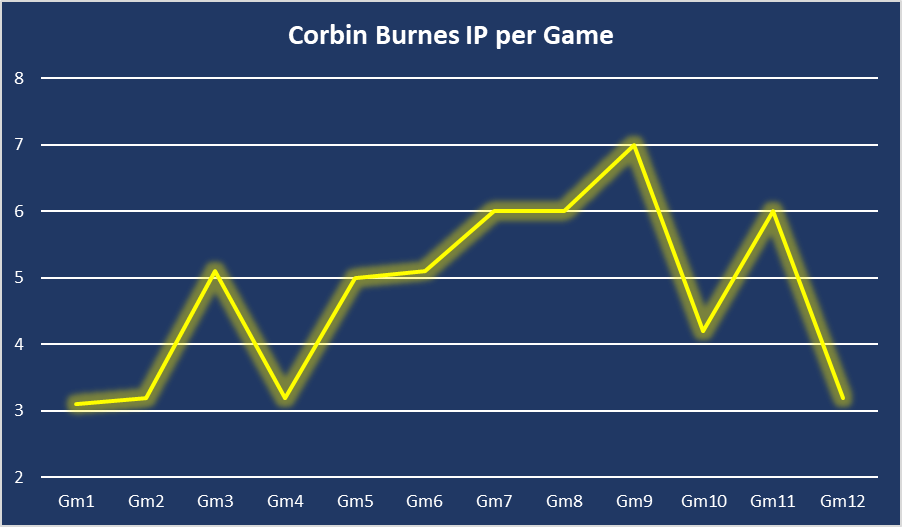Back in the 2020 preseason, the fantasy baseball community would have never dreamt of drafting a pitcher that was coming off an 8.82 ERA and a 1.84 WHIP in 49.0 innings pitched. That pitcher gave up 17 home runs in those limited innings, good for an unreal 38.6% home run to fly ball rate. That pitcher was Corbin Burnes, and his stock was cold… ice cold.
What?! Your league didn’t use Fantrax this past season? Inconceivable! Check out everything Fantrax has to offer and I’m sure you’ll come around to our way of thinking.
However, scouts and analysts alike knew there was more to Burnes. He possessed elite velocity, regularly hitting 96-mph with his fastball. His offspeed and breaking pitches had spin rates that were rivaled by few pitchers out there. He also generated a lot of horizontal movement on those breaking pitches. There was just something missing with Burnes.
That something was a deep arsenal. Burnes relied entirely too much on his four-seam fastball and his slider. His fastball percentage had a 52.5% usage, and his slider was at 31.0%. That fastball usage led to 13 home runs given up. Lucky for the baseball community, Corbin Burnes is a smart guy. He recognized his weakness, and fixed it.
He changed his pitch mix, and his stock has done a complete 180. Over 59.2 innings pitched in 2020, Burnes maintained an elite 2.11 ERA, a 1.02 WHIP, and 88 strikeouts. All of a sudden Corbin Burnes was hot… ‘Burnes’ing hot.
Corbin Burnes Pitch Arsenal & Pitch Mix Change
The first and most noticeable change that he made was to his pitch mix. As was stated earlier, Burnes was extremely reliant on his fastball. In 2020, his mix changed drastically. His most used pitch turned into his sinker. Following closely behind the sinker was his cutter, which prior to 2020 had been his least used pitch. He upped his changeup and curveball usage, while still using his slider over 10% of the time. This change, and deep arsenal usage, lead to one of the biggest turnarounds we’ve seen from a pitcher in recent memory. Below is a more thorough look at Burnes’s arsenal.
Sinker (33.1% usage)
Four-Seamer (2.5% usage)
If there’s one thing in today’s game that all pitchers thrive for, it’s velocity. That is not an issue for Burnes, who averaged 96-mph with his fastballs. The sinker was Burnes’s go-to offering, as he threw it 33.1% of the time, which was up nearly 30% from his 2019 usage. Burnes sits in the top 10 among starters in terms of velocity, and is only second behind Trevor Bauer in terms of spin rate. That combination makes this one of the more impressive sinkers in the game.
It really plays up to the type of pitcher that Burnes is used to being, as he typically feels more comfortable keeping his pitches low. That is quickly noticeable when comparing his two primary pitches in 2019 and 2020. In 2019, when he used his four-seamer as his primary pitch, Burnes had a grotesque 46.2% HR/FB rate, primarily throwing his “straight as an arrow” four-seamer in the heart of the zone. When you leave a fastball around there too often, pitchers get destroyed, it’s inevitable with today’s infatuation with launch angle. In 2020, he pounded his sinker low and arm-side (as seen above), and his HR/FB rate was at 5.6%. That is a night and day difference, and a major reason for his successful season.
As a result of his eye-numbing numbers with his four-seam fastball in 2019, Corbin Burnes basically eliminated it from his arsenal in 2020 (below). His four-seamer is much straighter than his sinker, and the 13.2-inches of drop gives hitters the perception that the pitch is actually rising when thrown. If Burnes ever needs to turn back to this pitch, he needs to figure out how to hit the upper quadrants of the strike zone with it. As Yoan Moncada figured out above, when he places that four-seamer where he wants, it makes him a nearly unhittable pitcher with the rest of his arsenal.
Cutter (31.5% usage)
As much as the sinker should be credited with Burnes’s breakout season, the cutter was perhaps even more crucial. Despite being thrown nearly one-third of his pitches, it was absolutely dominant. Opposing hitters hit .162 off the pitch, with a .203 SLG, a .258 xwOBA, a -2 degree launch angle, and an impressive 29.5% put away rate (strikeout percentage when thrown with two strikes). Those are elite numbers for a pitch that was thrown over 30% of the time, and it has an argument for being the best cutters in baseball.
A large reason this pitch is successful is due to how well it plays off his sinker and changeup. He typically keeps his cutter low, as it has heavy sink and left-to-right run despite being thrown at 93.2-mph. It is difficult for hitters to distinguish if they are getting the cutter low and on right side of the plate, or low and on the left side (from catcher’s view). Somewhat surprisingly, he prefers using it against left-handed hitters despite the pitch running in on them, as 77% of his cutters were thrown against lefties. Hey, I’m not here to argue it, just look at the results.
Slider (12.7% usage)
Even though it’s his third most used pitch, this is without a doubt Burnes’s most beautiful and effective pitch. His slider is a thing of nightmares for hitters, and a thing of sweet, sweet dreams for spectators. Thrown at 86.7-mph on average, Burnes gets 7.8-inches of break, and 35.6-inches of drop. Those are insane numbers for an 87-mph slider. Compared to sliders of similar velocity, Burnes gets 3.5-inches more break, and 1.6-inches more drop. If that wasn’t enough, the spin rate of 2,909-rpm Burnes’s slider gets only trails Walker Buehler and Trevor Bauer among qualified starting pitchers.
It was a devastating pitch running away from right handed hitters, as it was second most used pitch against the same-handed hitters. For as beautiful as the pitch was aesthetically, it was just as dominant results wise. In the shortened 2020 season, it had a .103 batting average against, a .150 xwOBA, a 27.3% swinging strike rate (tied for 3rd in baseball), a 60.3% whiff rate, and a 35.2% put away rate. Sorry to any opposing batters that have to go against the pitch in the future.
Changeup (11.2% usage)
Right behind his slider in terms of usage was his changeup. Used almost exclusively against left-handed hitters, this is yet another pitch that Burnes was really good with. Hitters once again couldn’t get above the Mendoza Line on the pitch, batting .182 against (with a .164 xBA). It also got the job done in the swing and miss department, sustaining a 20.4% swinging strike rate, a 44.2% whiff rate, and a 25.8% put away rate.
Thrown at 88.9-mph on average, this pitch almost isn’t fair to have when paired with his fastballs. It has 27.6-inches of drop, and breaks 12.4-inches horizontally. That is a lot of movement for a hard thrown changeup, even if the baseball savant numbers don’t support that.
Curveball (9.1% usage)
His curveball was his least used pitch outside of the four-seam fastball, but it only trailed his changeup by two percent usage. That’s a testament to how deep his arsenal gets. He is a little more wild with this pitch relative to the rest of his arsenal, but still primarily focuses on keeping the pitch down and break-side.
He primarily runs his curveball out of the zone, uses it to get weak contact, and also strikeouts. Only thrown 92 times on the year, Burnes struck out 13 hitters with the pitch. That’s a really good number. Of those 93 throws, there were only eight batted ball events.
Concerns: Innings Worries and Getting Under Control
There are concerns here with Corbin Burnes. First is the fact he was primarily a reliever in 2019, and then followed that up with a 60-inning season in 2020. There is a limit to how many innings Burnes will throw in 2021. How many innings he throws will be what makes or breaks his value. If he can reach 150 innings, then he could potentially return plenty of value with his ability to strike out hitters and limit runs. If it’s less, then how can anyone confidently say he will be better than pitchers like Zach Plesac, Carlos Carrasco, Kyle Hendricks, Zack Wheeler, etc. Pitchers who will maintain admirable ratios, and also likely pitch 180+ innings.
The next issue for Burnes is his control. He had a career high walk rate in 2020, sitting at 10.0%. The heavy break on his pitches likely plays a large role, as the 35.3% zone rate was well below league average. With that low of a zone rate, and also factoring in a 52.9% F-Strike rate (first pitch strike), hitters simply needed to not swing against him and they would draw a deep count.
It obviously worked in terms of limiting runs, as those numbers were well below his 2018 and 2019 ratios. That’s fine if his owners want great ratios and good strikeout numbers. What they don’t want is their SP2 throwing less than five innings (which he did five times in 2020). Most of those short innings were a result of him following an opener, but he still struggled with control in those starts.
Corbin Burnes 2021 Outlook
In sum, Corbin Burnes has one of the overall best pitching arsenals in the game today. He has elite velocity, movement, and spin on his six pitches. He is one of the more GIFable pitchers in the game today. The swing and miss stuff is undeniable, as his 14.5% swinging strike rate and 36.7% strikeout rate are awesome starting pitcher numbers.
Of grave concern is the fact Burnes currently has an ADP of 65 in the 2EarlyMocks. I am not sure how to feel about drafting a pitcher as an SP2 that only has four quality starts in his career. However, the quality starts aren’t the concern. If he can even go five innings with his ability to strike out batters and limit runs, he isn’t as risky of an option as his profile suggests. It is eerily similar to Tyler Glasnow, who has returned high end starting pitcher value despite not going deep into games. The bigger concern is with Burnes’s success came a decline in control. He will need to lower that walk rate to get anywhere near a consistent six inning pitcher.
Despite those innings issues, Burnes has a ceiling around where he is going. He can give fantasy owners 150 innings, with 200 or more strikeouts, and a low three to high two ERA. That is likely his ceiling in 2021. If owners are ok with drafting that, then go for it. Make sure to pair him with one of the elite pitchers, and draft safe with the next few starting pitcher options. Then enjoy owning one of the most talented pitchers in the game today. I know I probably will.
The paint is still wet on the 2020 MLB season, but we are already preparing for next year. Keep track of all our 2020-21 MLB Offseason Analysis.
Fantrax was one of the fastest-growing fantasy sites of 2018/2019 and we’re not slowing down in 2020! With multi-team trades, designated commissioner/league managers, and drag/drop easy click methods, Fantrax is sure to excite the serious fantasy sports fan – sign up now for a free year at Fantrax.com.

